Effectiveness of VAP Care Bundles in Adult ICU: Literature Review
VerifiedAdded on 2023/06/09
|15
|4185
|120
Literature Review
AI Summary
This literature review examines the efficacy and feasibility of ventilator-associated pneumonia (VAP) care bundles in preventing VAP in adult intensive care units (ICU). The review synthesizes findings from various databases, including CINAHL, PubMed, and Medline, focusing on articles published from 2009 onwards that evaluated VAP care bundles as the primary intervention. The review discusses the Institute for Healthcare Improvement's (IHI) recommendations for VAP prevention, highlighting the use of care bundles such as oral care with chlorhexidine, head of bed elevation, stress ulcer prophylaxis, daily sedation assessment, and breathing trials. The analysis covers single-center and multi-center studies, comparing different bundle designs, compliance rates, and the impact of individual components like oral chlorhexidine. The review also addresses the importance of multidisciplinary teamwork, continuous education, and the influence of organizational climate and safety culture on VAP bundle success. Furthermore, it acknowledges the limitations in current research, such as the lack of consideration for individual patient risk factors and challenges faced by healthcare staff, emphasizing the need for future studies to optimize VAP prevention strategies and improve patient outcomes.
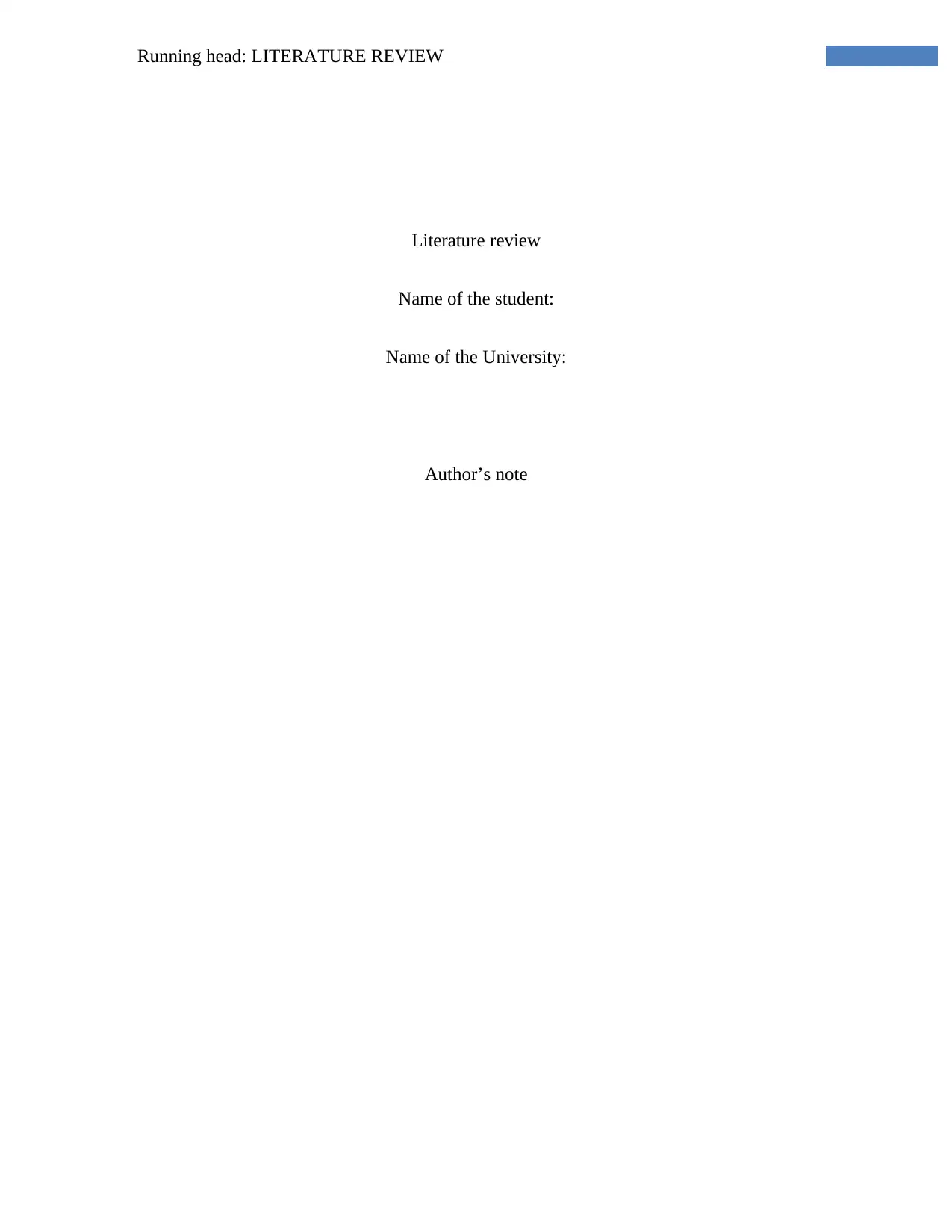
Running head: LITERATURE REVIEW
Literature review
Name of the student:
Name of the University:
Author’s note
Literature review
Name of the student:
Name of the University:
Author’s note
Paraphrase This Document
Need a fresh take? Get an instant paraphrase of this document with our AI Paraphraser
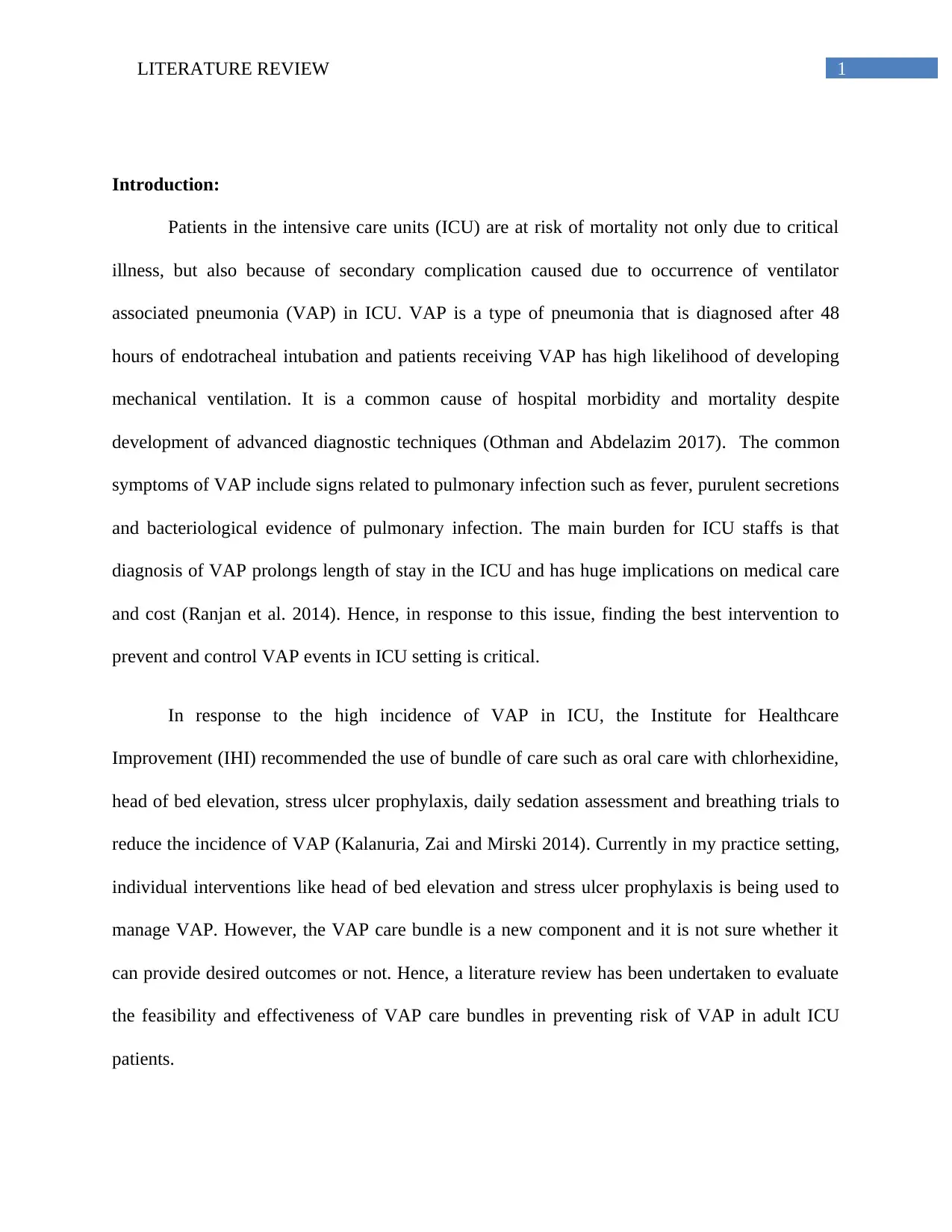
1LITERATURE REVIEW
Introduction:
Patients in the intensive care units (ICU) are at risk of mortality not only due to critical
illness, but also because of secondary complication caused due to occurrence of ventilator
associated pneumonia (VAP) in ICU. VAP is a type of pneumonia that is diagnosed after 48
hours of endotracheal intubation and patients receiving VAP has high likelihood of developing
mechanical ventilation. It is a common cause of hospital morbidity and mortality despite
development of advanced diagnostic techniques (Othman and Abdelazim 2017). The common
symptoms of VAP include signs related to pulmonary infection such as fever, purulent secretions
and bacteriological evidence of pulmonary infection. The main burden for ICU staffs is that
diagnosis of VAP prolongs length of stay in the ICU and has huge implications on medical care
and cost (Ranjan et al. 2014). Hence, in response to this issue, finding the best intervention to
prevent and control VAP events in ICU setting is critical.
In response to the high incidence of VAP in ICU, the Institute for Healthcare
Improvement (IHI) recommended the use of bundle of care such as oral care with chlorhexidine,
head of bed elevation, stress ulcer prophylaxis, daily sedation assessment and breathing trials to
reduce the incidence of VAP (Kalanuria, Zai and Mirski 2014). Currently in my practice setting,
individual interventions like head of bed elevation and stress ulcer prophylaxis is being used to
manage VAP. However, the VAP care bundle is a new component and it is not sure whether it
can provide desired outcomes or not. Hence, a literature review has been undertaken to evaluate
the feasibility and effectiveness of VAP care bundles in preventing risk of VAP in adult ICU
patients.
Introduction:
Patients in the intensive care units (ICU) are at risk of mortality not only due to critical
illness, but also because of secondary complication caused due to occurrence of ventilator
associated pneumonia (VAP) in ICU. VAP is a type of pneumonia that is diagnosed after 48
hours of endotracheal intubation and patients receiving VAP has high likelihood of developing
mechanical ventilation. It is a common cause of hospital morbidity and mortality despite
development of advanced diagnostic techniques (Othman and Abdelazim 2017). The common
symptoms of VAP include signs related to pulmonary infection such as fever, purulent secretions
and bacteriological evidence of pulmonary infection. The main burden for ICU staffs is that
diagnosis of VAP prolongs length of stay in the ICU and has huge implications on medical care
and cost (Ranjan et al. 2014). Hence, in response to this issue, finding the best intervention to
prevent and control VAP events in ICU setting is critical.
In response to the high incidence of VAP in ICU, the Institute for Healthcare
Improvement (IHI) recommended the use of bundle of care such as oral care with chlorhexidine,
head of bed elevation, stress ulcer prophylaxis, daily sedation assessment and breathing trials to
reduce the incidence of VAP (Kalanuria, Zai and Mirski 2014). Currently in my practice setting,
individual interventions like head of bed elevation and stress ulcer prophylaxis is being used to
manage VAP. However, the VAP care bundle is a new component and it is not sure whether it
can provide desired outcomes or not. Hence, a literature review has been undertaken to evaluate
the feasibility and effectiveness of VAP care bundles in preventing risk of VAP in adult ICU
patients.
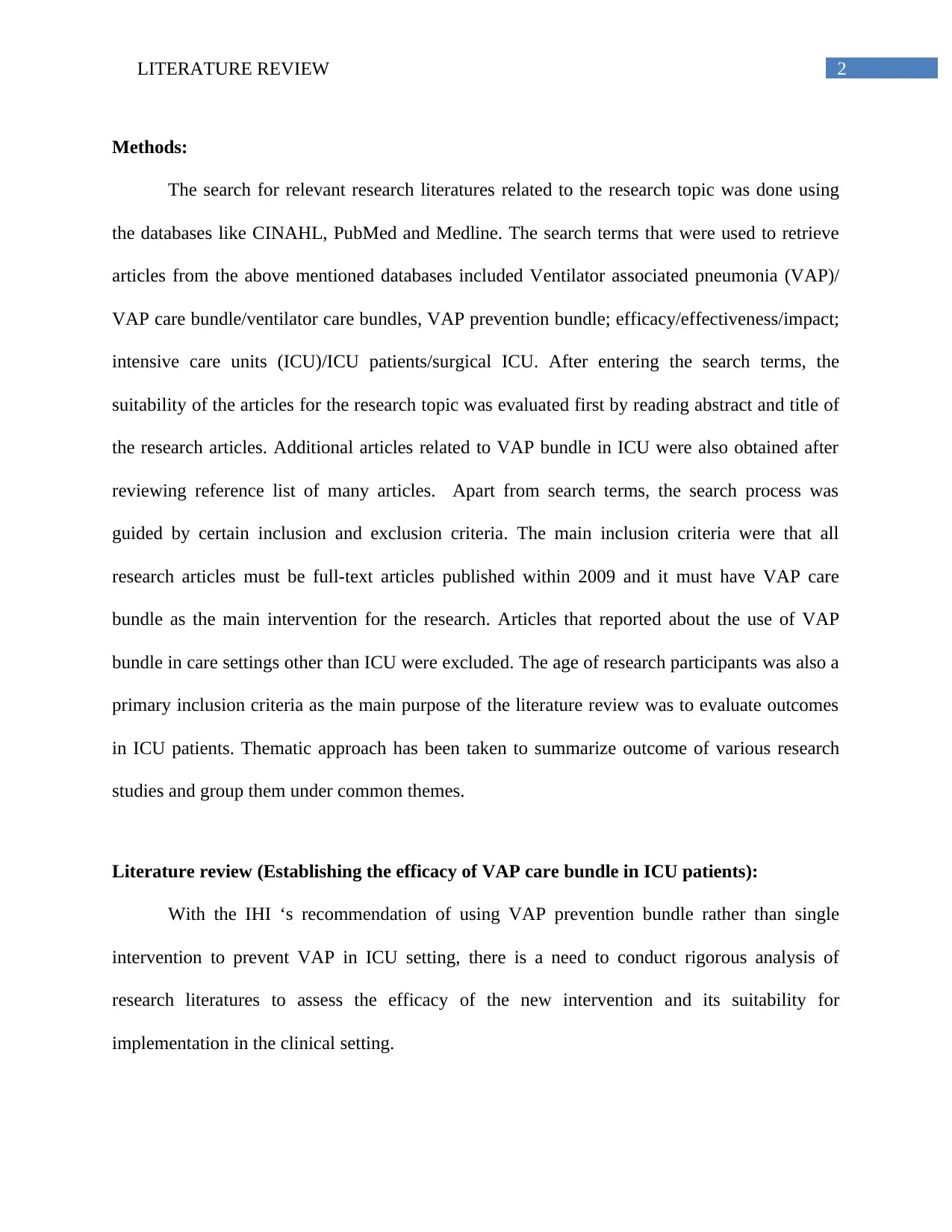
2LITERATURE REVIEW
Methods:
The search for relevant research literatures related to the research topic was done using
the databases like CINAHL, PubMed and Medline. The search terms that were used to retrieve
articles from the above mentioned databases included Ventilator associated pneumonia (VAP)/
VAP care bundle/ventilator care bundles, VAP prevention bundle; efficacy/effectiveness/impact;
intensive care units (ICU)/ICU patients/surgical ICU. After entering the search terms, the
suitability of the articles for the research topic was evaluated first by reading abstract and title of
the research articles. Additional articles related to VAP bundle in ICU were also obtained after
reviewing reference list of many articles. Apart from search terms, the search process was
guided by certain inclusion and exclusion criteria. The main inclusion criteria were that all
research articles must be full-text articles published within 2009 and it must have VAP care
bundle as the main intervention for the research. Articles that reported about the use of VAP
bundle in care settings other than ICU were excluded. The age of research participants was also a
primary inclusion criteria as the main purpose of the literature review was to evaluate outcomes
in ICU patients. Thematic approach has been taken to summarize outcome of various research
studies and group them under common themes.
Literature review (Establishing the efficacy of VAP care bundle in ICU patients):
With the IHI ‘s recommendation of using VAP prevention bundle rather than single
intervention to prevent VAP in ICU setting, there is a need to conduct rigorous analysis of
research literatures to assess the efficacy of the new intervention and its suitability for
implementation in the clinical setting.
Methods:
The search for relevant research literatures related to the research topic was done using
the databases like CINAHL, PubMed and Medline. The search terms that were used to retrieve
articles from the above mentioned databases included Ventilator associated pneumonia (VAP)/
VAP care bundle/ventilator care bundles, VAP prevention bundle; efficacy/effectiveness/impact;
intensive care units (ICU)/ICU patients/surgical ICU. After entering the search terms, the
suitability of the articles for the research topic was evaluated first by reading abstract and title of
the research articles. Additional articles related to VAP bundle in ICU were also obtained after
reviewing reference list of many articles. Apart from search terms, the search process was
guided by certain inclusion and exclusion criteria. The main inclusion criteria were that all
research articles must be full-text articles published within 2009 and it must have VAP care
bundle as the main intervention for the research. Articles that reported about the use of VAP
bundle in care settings other than ICU were excluded. The age of research participants was also a
primary inclusion criteria as the main purpose of the literature review was to evaluate outcomes
in ICU patients. Thematic approach has been taken to summarize outcome of various research
studies and group them under common themes.
Literature review (Establishing the efficacy of VAP care bundle in ICU patients):
With the IHI ‘s recommendation of using VAP prevention bundle rather than single
intervention to prevent VAP in ICU setting, there is a need to conduct rigorous analysis of
research literatures to assess the efficacy of the new intervention and its suitability for
implementation in the clinical setting.
⊘ This is a preview!⊘
Do you want full access?
Subscribe today to unlock all pages.

Trusted by 1+ million students worldwide
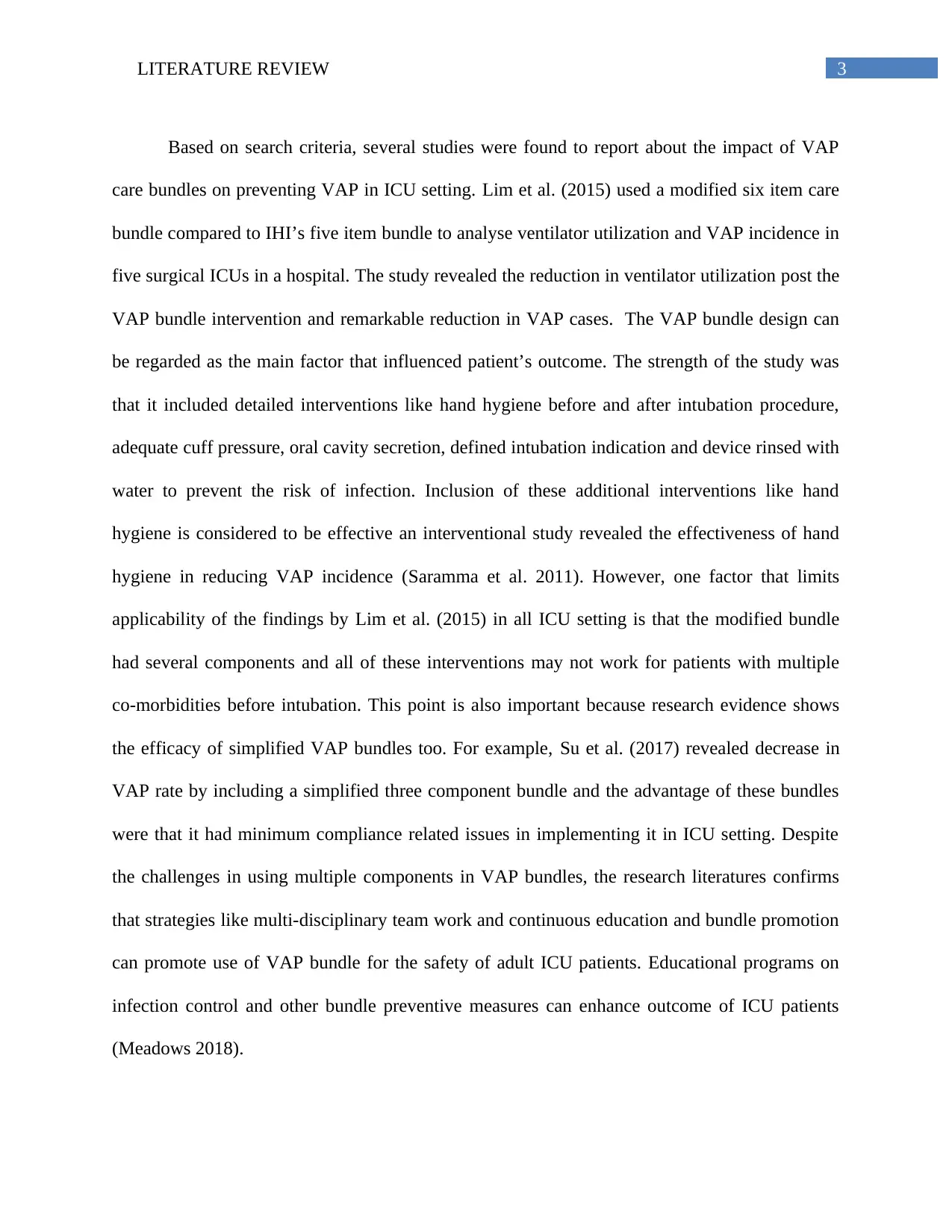
3LITERATURE REVIEW
Based on search criteria, several studies were found to report about the impact of VAP
care bundles on preventing VAP in ICU setting. Lim et al. (2015) used a modified six item care
bundle compared to IHI’s five item bundle to analyse ventilator utilization and VAP incidence in
five surgical ICUs in a hospital. The study revealed the reduction in ventilator utilization post the
VAP bundle intervention and remarkable reduction in VAP cases. The VAP bundle design can
be regarded as the main factor that influenced patient’s outcome. The strength of the study was
that it included detailed interventions like hand hygiene before and after intubation procedure,
adequate cuff pressure, oral cavity secretion, defined intubation indication and device rinsed with
water to prevent the risk of infection. Inclusion of these additional interventions like hand
hygiene is considered to be effective an interventional study revealed the effectiveness of hand
hygiene in reducing VAP incidence (Saramma et al. 2011). However, one factor that limits
applicability of the findings by Lim et al. (2015) in all ICU setting is that the modified bundle
had several components and all of these interventions may not work for patients with multiple
co-morbidities before intubation. This point is also important because research evidence shows
the efficacy of simplified VAP bundles too. For example, Su et al. (2017) revealed decrease in
VAP rate by including a simplified three component bundle and the advantage of these bundles
were that it had minimum compliance related issues in implementing it in ICU setting. Despite
the challenges in using multiple components in VAP bundles, the research literatures confirms
that strategies like multi-disciplinary team work and continuous education and bundle promotion
can promote use of VAP bundle for the safety of adult ICU patients. Educational programs on
infection control and other bundle preventive measures can enhance outcome of ICU patients
(Meadows 2018).
Based on search criteria, several studies were found to report about the impact of VAP
care bundles on preventing VAP in ICU setting. Lim et al. (2015) used a modified six item care
bundle compared to IHI’s five item bundle to analyse ventilator utilization and VAP incidence in
five surgical ICUs in a hospital. The study revealed the reduction in ventilator utilization post the
VAP bundle intervention and remarkable reduction in VAP cases. The VAP bundle design can
be regarded as the main factor that influenced patient’s outcome. The strength of the study was
that it included detailed interventions like hand hygiene before and after intubation procedure,
adequate cuff pressure, oral cavity secretion, defined intubation indication and device rinsed with
water to prevent the risk of infection. Inclusion of these additional interventions like hand
hygiene is considered to be effective an interventional study revealed the effectiveness of hand
hygiene in reducing VAP incidence (Saramma et al. 2011). However, one factor that limits
applicability of the findings by Lim et al. (2015) in all ICU setting is that the modified bundle
had several components and all of these interventions may not work for patients with multiple
co-morbidities before intubation. This point is also important because research evidence shows
the efficacy of simplified VAP bundles too. For example, Su et al. (2017) revealed decrease in
VAP rate by including a simplified three component bundle and the advantage of these bundles
were that it had minimum compliance related issues in implementing it in ICU setting. Despite
the challenges in using multiple components in VAP bundles, the research literatures confirms
that strategies like multi-disciplinary team work and continuous education and bundle promotion
can promote use of VAP bundle for the safety of adult ICU patients. Educational programs on
infection control and other bundle preventive measures can enhance outcome of ICU patients
(Meadows 2018).
Paraphrase This Document
Need a fresh take? Get an instant paraphrase of this document with our AI Paraphraser

4LITERATURE REVIEW
Apart from single centre studies, many multiple centre studies were also done to
determine the efficacy of VAP bundles in different hospital ICU units. The analysis of multi-
center study was necessary to confirm whether VAP prevention bundle is suitable to be
implemented in different health care centers or not. In contrast to the single centre study done by
Lim et al. (2015), Eom et al. (2014) evaluated the impact of the care bundles by conducting a
quasi-experimental study in ICUs of six university hospitals. The VAP bundle in the study
included components like head of bed elevation, peptic ulcer prophylaxis and venous thrombous
prophylaxis and oral decontamination with oral chlorhexidine. Statistically significant reduction
in VAP rate was found after the introduction of the VAP bundle. One of the major arguments
regarding the use of VAP bundle is that it has various components and there are discordances
regarding the benefits of these components. The advantage of the research by Eom et al. (2014)
is that it evaluated the compliance rate for all of the components. Greatest impact on VAP
reduction was found because of high compliance with oral decontamination with chlorhexidine.
Other components also achieved good compliance rate. This finding is consistent with other
research evidence as Enwere et al. (2016) clearly revealed the effectiveness of oral chlorhexidine
by comparing the use of VAP bundle and chlorhexidine in ICU patients compared to those
patients who did not received the prophlaxis. Hence, these evidences can be utilized to reduce
health care cost and patient morbidity caused due to incidence of VAP.
Another question that may arise while implementing VAP bundle in ICU setting is that
whether all the elements of the VAP bundle can be easily adopted by health care staffs or not.
Pogorzelska et al. (2011) looked to explore the question by examining the adoption of the
ventilator bundle element and evaluating the effectiveness of individual elements. The validity of
the research has been enhanced by the use of multi-centre analysis and conducting research in
Apart from single centre studies, many multiple centre studies were also done to
determine the efficacy of VAP bundles in different hospital ICU units. The analysis of multi-
center study was necessary to confirm whether VAP prevention bundle is suitable to be
implemented in different health care centers or not. In contrast to the single centre study done by
Lim et al. (2015), Eom et al. (2014) evaluated the impact of the care bundles by conducting a
quasi-experimental study in ICUs of six university hospitals. The VAP bundle in the study
included components like head of bed elevation, peptic ulcer prophylaxis and venous thrombous
prophylaxis and oral decontamination with oral chlorhexidine. Statistically significant reduction
in VAP rate was found after the introduction of the VAP bundle. One of the major arguments
regarding the use of VAP bundle is that it has various components and there are discordances
regarding the benefits of these components. The advantage of the research by Eom et al. (2014)
is that it evaluated the compliance rate for all of the components. Greatest impact on VAP
reduction was found because of high compliance with oral decontamination with chlorhexidine.
Other components also achieved good compliance rate. This finding is consistent with other
research evidence as Enwere et al. (2016) clearly revealed the effectiveness of oral chlorhexidine
by comparing the use of VAP bundle and chlorhexidine in ICU patients compared to those
patients who did not received the prophlaxis. Hence, these evidences can be utilized to reduce
health care cost and patient morbidity caused due to incidence of VAP.
Another question that may arise while implementing VAP bundle in ICU setting is that
whether all the elements of the VAP bundle can be easily adopted by health care staffs or not.
Pogorzelska et al. (2011) looked to explore the question by examining the adoption of the
ventilator bundle element and evaluating the effectiveness of individual elements. The validity of
the research has been enhanced by the use of multi-centre analysis and conducting research in
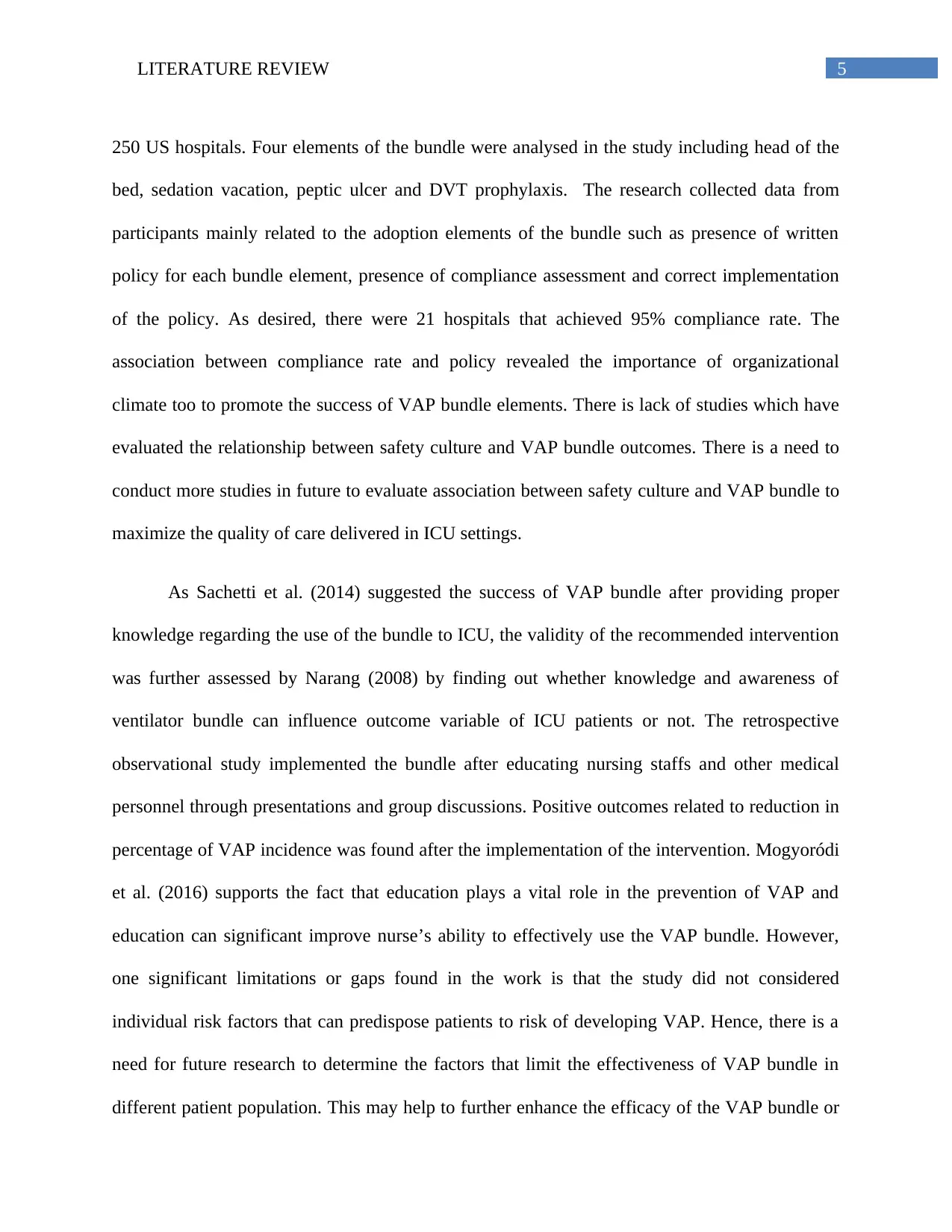
5LITERATURE REVIEW
250 US hospitals. Four elements of the bundle were analysed in the study including head of the
bed, sedation vacation, peptic ulcer and DVT prophylaxis. The research collected data from
participants mainly related to the adoption elements of the bundle such as presence of written
policy for each bundle element, presence of compliance assessment and correct implementation
of the policy. As desired, there were 21 hospitals that achieved 95% compliance rate. The
association between compliance rate and policy revealed the importance of organizational
climate too to promote the success of VAP bundle elements. There is lack of studies which have
evaluated the relationship between safety culture and VAP bundle outcomes. There is a need to
conduct more studies in future to evaluate association between safety culture and VAP bundle to
maximize the quality of care delivered in ICU settings.
As Sachetti et al. (2014) suggested the success of VAP bundle after providing proper
knowledge regarding the use of the bundle to ICU, the validity of the recommended intervention
was further assessed by Narang (2008) by finding out whether knowledge and awareness of
ventilator bundle can influence outcome variable of ICU patients or not. The retrospective
observational study implemented the bundle after educating nursing staffs and other medical
personnel through presentations and group discussions. Positive outcomes related to reduction in
percentage of VAP incidence was found after the implementation of the intervention. Mogyoródi
et al. (2016) supports the fact that education plays a vital role in the prevention of VAP and
education can significant improve nurse’s ability to effectively use the VAP bundle. However,
one significant limitations or gaps found in the work is that the study did not considered
individual risk factors that can predispose patients to risk of developing VAP. Hence, there is a
need for future research to determine the factors that limit the effectiveness of VAP bundle in
different patient population. This may help to further enhance the efficacy of the VAP bundle or
250 US hospitals. Four elements of the bundle were analysed in the study including head of the
bed, sedation vacation, peptic ulcer and DVT prophylaxis. The research collected data from
participants mainly related to the adoption elements of the bundle such as presence of written
policy for each bundle element, presence of compliance assessment and correct implementation
of the policy. As desired, there were 21 hospitals that achieved 95% compliance rate. The
association between compliance rate and policy revealed the importance of organizational
climate too to promote the success of VAP bundle elements. There is lack of studies which have
evaluated the relationship between safety culture and VAP bundle outcomes. There is a need to
conduct more studies in future to evaluate association between safety culture and VAP bundle to
maximize the quality of care delivered in ICU settings.
As Sachetti et al. (2014) suggested the success of VAP bundle after providing proper
knowledge regarding the use of the bundle to ICU, the validity of the recommended intervention
was further assessed by Narang (2008) by finding out whether knowledge and awareness of
ventilator bundle can influence outcome variable of ICU patients or not. The retrospective
observational study implemented the bundle after educating nursing staffs and other medical
personnel through presentations and group discussions. Positive outcomes related to reduction in
percentage of VAP incidence was found after the implementation of the intervention. Mogyoródi
et al. (2016) supports the fact that education plays a vital role in the prevention of VAP and
education can significant improve nurse’s ability to effectively use the VAP bundle. However,
one significant limitations or gaps found in the work is that the study did not considered
individual risk factors that can predispose patients to risk of developing VAP. Hence, there is a
need for future research to determine the factors that limit the effectiveness of VAP bundle in
different patient population. This may help to further enhance the efficacy of the VAP bundle or
⊘ This is a preview!⊘
Do you want full access?
Subscribe today to unlock all pages.

Trusted by 1+ million students worldwide
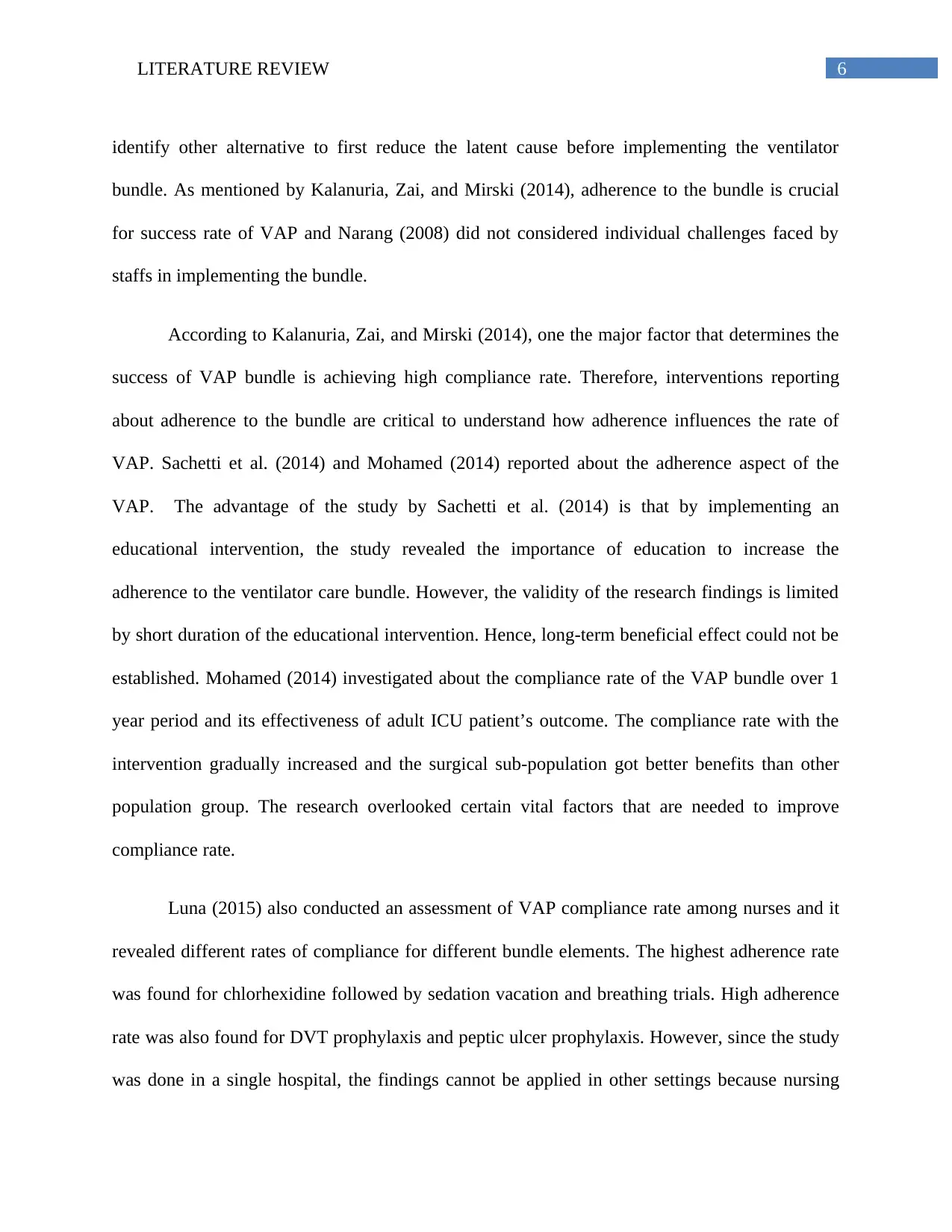
6LITERATURE REVIEW
identify other alternative to first reduce the latent cause before implementing the ventilator
bundle. As mentioned by Kalanuria, Zai, and Mirski (2014), adherence to the bundle is crucial
for success rate of VAP and Narang (2008) did not considered individual challenges faced by
staffs in implementing the bundle.
According to Kalanuria, Zai, and Mirski (2014), one the major factor that determines the
success of VAP bundle is achieving high compliance rate. Therefore, interventions reporting
about adherence to the bundle are critical to understand how adherence influences the rate of
VAP. Sachetti et al. (2014) and Mohamed (2014) reported about the adherence aspect of the
VAP. The advantage of the study by Sachetti et al. (2014) is that by implementing an
educational intervention, the study revealed the importance of education to increase the
adherence to the ventilator care bundle. However, the validity of the research findings is limited
by short duration of the educational intervention. Hence, long-term beneficial effect could not be
established. Mohamed (2014) investigated about the compliance rate of the VAP bundle over 1
year period and its effectiveness of adult ICU patient’s outcome. The compliance rate with the
intervention gradually increased and the surgical sub-population got better benefits than other
population group. The research overlooked certain vital factors that are needed to improve
compliance rate.
Luna (2015) also conducted an assessment of VAP compliance rate among nurses and it
revealed different rates of compliance for different bundle elements. The highest adherence rate
was found for chlorhexidine followed by sedation vacation and breathing trials. High adherence
rate was also found for DVT prophylaxis and peptic ulcer prophylaxis. However, since the study
was done in a single hospital, the findings cannot be applied in other settings because nursing
identify other alternative to first reduce the latent cause before implementing the ventilator
bundle. As mentioned by Kalanuria, Zai, and Mirski (2014), adherence to the bundle is crucial
for success rate of VAP and Narang (2008) did not considered individual challenges faced by
staffs in implementing the bundle.
According to Kalanuria, Zai, and Mirski (2014), one the major factor that determines the
success of VAP bundle is achieving high compliance rate. Therefore, interventions reporting
about adherence to the bundle are critical to understand how adherence influences the rate of
VAP. Sachetti et al. (2014) and Mohamed (2014) reported about the adherence aspect of the
VAP. The advantage of the study by Sachetti et al. (2014) is that by implementing an
educational intervention, the study revealed the importance of education to increase the
adherence to the ventilator care bundle. However, the validity of the research findings is limited
by short duration of the educational intervention. Hence, long-term beneficial effect could not be
established. Mohamed (2014) investigated about the compliance rate of the VAP bundle over 1
year period and its effectiveness of adult ICU patient’s outcome. The compliance rate with the
intervention gradually increased and the surgical sub-population got better benefits than other
population group. The research overlooked certain vital factors that are needed to improve
compliance rate.
Luna (2015) also conducted an assessment of VAP compliance rate among nurses and it
revealed different rates of compliance for different bundle elements. The highest adherence rate
was found for chlorhexidine followed by sedation vacation and breathing trials. High adherence
rate was also found for DVT prophylaxis and peptic ulcer prophylaxis. However, since the study
was done in a single hospital, the findings cannot be applied in other settings because nursing
Paraphrase This Document
Need a fresh take? Get an instant paraphrase of this document with our AI Paraphraser

7LITERATURE REVIEW
education and other factors might also influence nurse’s perception regarding use of each
elements of the VAP bundle. The point is also validated by the findings from the study by
Alja’afreh, Mosleh and Habashneh (2018) which revealed a contrasting finding that ICU nurse
have poor perception and attitude towards oral care for mechanically ventilated patients. The
study was done in three Jordanian hospitals and it was found that nurses did not adhere to
minimal standards of oral care. However, nurses had positive attitude towards oral care. This
outcome might be influenced by the in-hospital training protocol and knowledge and experience
of nurse too. Hence, reviewing findings from multi-centre analysis can confirm whether nurse’s
attitudes towards oral care are influenced by training or other factors.
Adherence to VAP bundle is critical to the success of the intervention. However, the gap
in the research presented above is that most studies were quantitative studies and it gave limited
ideas regarding the challenges a nurse can face in implementing different elements of the bundle.
Analysis of qualitative studies was needed to get in-depth information related to challenges in
using the protocol. Various studies investigated about the adherence or compliance to Institution-
specific VAP guidelines. Kiyoshi-Teo et al. (2014) argues that availability of guidelines alone do
not predict adherence to the recommended strategies. The author came to this conclusion after
conducting a cross sectional descriptive study where to identify facilitators and barriers to
adherence to the guideline for VAP prevention. Attitude towards the guideline was measured by
agreement with the guideline content, intention and self-efficacy of users. Nurse’s professional
characteristics did not influence the guideline and time availability was a factor that influence
adherence to oral care. However, certain factors like lack of causal conclusion and self-reported
data limits the reliability of the research findings. Despite this limitation, Kiyoshi-Teo and
Blegen (2015) suggest that perception of users towards VAP bundle must be examined to
education and other factors might also influence nurse’s perception regarding use of each
elements of the VAP bundle. The point is also validated by the findings from the study by
Alja’afreh, Mosleh and Habashneh (2018) which revealed a contrasting finding that ICU nurse
have poor perception and attitude towards oral care for mechanically ventilated patients. The
study was done in three Jordanian hospitals and it was found that nurses did not adhere to
minimal standards of oral care. However, nurses had positive attitude towards oral care. This
outcome might be influenced by the in-hospital training protocol and knowledge and experience
of nurse too. Hence, reviewing findings from multi-centre analysis can confirm whether nurse’s
attitudes towards oral care are influenced by training or other factors.
Adherence to VAP bundle is critical to the success of the intervention. However, the gap
in the research presented above is that most studies were quantitative studies and it gave limited
ideas regarding the challenges a nurse can face in implementing different elements of the bundle.
Analysis of qualitative studies was needed to get in-depth information related to challenges in
using the protocol. Various studies investigated about the adherence or compliance to Institution-
specific VAP guidelines. Kiyoshi-Teo et al. (2014) argues that availability of guidelines alone do
not predict adherence to the recommended strategies. The author came to this conclusion after
conducting a cross sectional descriptive study where to identify facilitators and barriers to
adherence to the guideline for VAP prevention. Attitude towards the guideline was measured by
agreement with the guideline content, intention and self-efficacy of users. Nurse’s professional
characteristics did not influence the guideline and time availability was a factor that influence
adherence to oral care. However, certain factors like lack of causal conclusion and self-reported
data limits the reliability of the research findings. Despite this limitation, Kiyoshi-Teo and
Blegen (2015) suggest that perception of users towards VAP bundle must be examined to

8LITERATURE REVIEW
promote success of the intervention. This is also theoretically valid conclusion as according to
the Health Belief Model, individual health behaviour is dependent on attitudes and beliefs and
examination of attitudes can help health care personnel to identify benefits and barriers to the use
of ventilator bundle (Meadows 2018).
The literature review suggest that various bundle element, institutional factors and
nursing’s staffs perception influence adherence to the VAP bundle while caring for ICU patients.
In response to these issues presented in the research articles, there is a need to identify best
strategies that can promote success of the bundle intervention. Borgert, Goossens and
Dongelmans (2015) used systematic review method to identify the effective strategies for the
implementation of care bundles for ICU patients. The significance of the study is that many
strategies has been implemented in the past, however there is lack of understanding regarding the
most effective steps to implement care bundles. The findings from the research reveals
education, reminders and audit feedback as the most frequently used strategies implemented in
various hospital setting. However, the compliance to the care bundle is influenced by type and
number of element and. Lawrence and Fulbrook (2011) states that compliance with four bundle
element is possible as evidenced by the review of various ventilator care bundle with four
elements. The gap found in the study by Borgert, Goossens and Dongelmans (2015) is that
highlights about the frequency and types of strategies used to implement VAP bundles, however
the study lacked conclusion regarding the strategy that can yield highest compliance to the care
bundle. This was because of the heterogeneity of the data.
To clarify regarding the effective steps to implement the VAP bundle, review of single
strategies used in research were done. There was no study which individually reported about
promote success of the intervention. This is also theoretically valid conclusion as according to
the Health Belief Model, individual health behaviour is dependent on attitudes and beliefs and
examination of attitudes can help health care personnel to identify benefits and barriers to the use
of ventilator bundle (Meadows 2018).
The literature review suggest that various bundle element, institutional factors and
nursing’s staffs perception influence adherence to the VAP bundle while caring for ICU patients.
In response to these issues presented in the research articles, there is a need to identify best
strategies that can promote success of the bundle intervention. Borgert, Goossens and
Dongelmans (2015) used systematic review method to identify the effective strategies for the
implementation of care bundles for ICU patients. The significance of the study is that many
strategies has been implemented in the past, however there is lack of understanding regarding the
most effective steps to implement care bundles. The findings from the research reveals
education, reminders and audit feedback as the most frequently used strategies implemented in
various hospital setting. However, the compliance to the care bundle is influenced by type and
number of element and. Lawrence and Fulbrook (2011) states that compliance with four bundle
element is possible as evidenced by the review of various ventilator care bundle with four
elements. The gap found in the study by Borgert, Goossens and Dongelmans (2015) is that
highlights about the frequency and types of strategies used to implement VAP bundles, however
the study lacked conclusion regarding the strategy that can yield highest compliance to the care
bundle. This was because of the heterogeneity of the data.
To clarify regarding the effective steps to implement the VAP bundle, review of single
strategies used in research were done. There was no study which individually reported about
⊘ This is a preview!⊘
Do you want full access?
Subscribe today to unlock all pages.

Trusted by 1+ million students worldwide
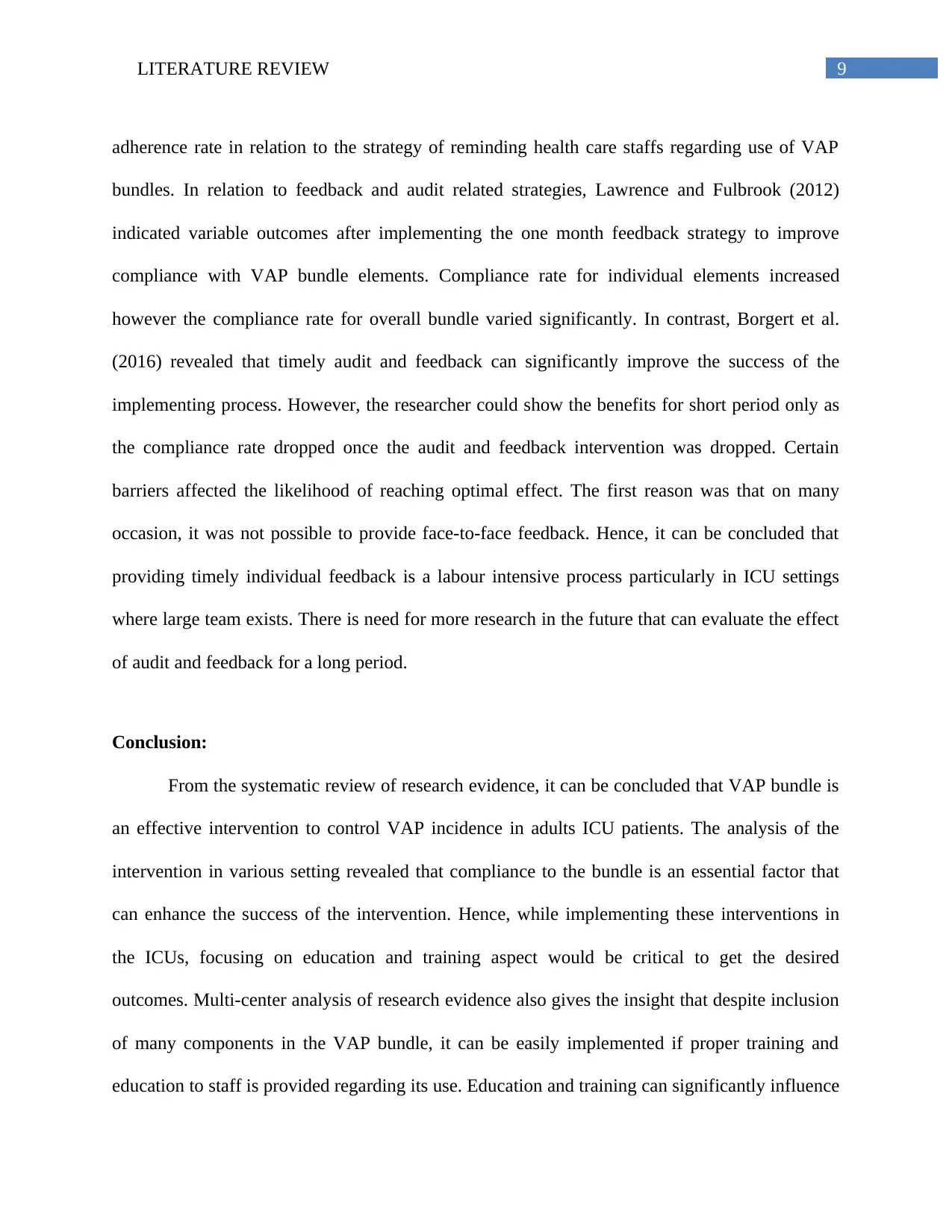
9LITERATURE REVIEW
adherence rate in relation to the strategy of reminding health care staffs regarding use of VAP
bundles. In relation to feedback and audit related strategies, Lawrence and Fulbrook (2012)
indicated variable outcomes after implementing the one month feedback strategy to improve
compliance with VAP bundle elements. Compliance rate for individual elements increased
however the compliance rate for overall bundle varied significantly. In contrast, Borgert et al.
(2016) revealed that timely audit and feedback can significantly improve the success of the
implementing process. However, the researcher could show the benefits for short period only as
the compliance rate dropped once the audit and feedback intervention was dropped. Certain
barriers affected the likelihood of reaching optimal effect. The first reason was that on many
occasion, it was not possible to provide face-to-face feedback. Hence, it can be concluded that
providing timely individual feedback is a labour intensive process particularly in ICU settings
where large team exists. There is need for more research in the future that can evaluate the effect
of audit and feedback for a long period.
Conclusion:
From the systematic review of research evidence, it can be concluded that VAP bundle is
an effective intervention to control VAP incidence in adults ICU patients. The analysis of the
intervention in various setting revealed that compliance to the bundle is an essential factor that
can enhance the success of the intervention. Hence, while implementing these interventions in
the ICUs, focusing on education and training aspect would be critical to get the desired
outcomes. Multi-center analysis of research evidence also gives the insight that despite inclusion
of many components in the VAP bundle, it can be easily implemented if proper training and
education to staff is provided regarding its use. Education and training can significantly influence
adherence rate in relation to the strategy of reminding health care staffs regarding use of VAP
bundles. In relation to feedback and audit related strategies, Lawrence and Fulbrook (2012)
indicated variable outcomes after implementing the one month feedback strategy to improve
compliance with VAP bundle elements. Compliance rate for individual elements increased
however the compliance rate for overall bundle varied significantly. In contrast, Borgert et al.
(2016) revealed that timely audit and feedback can significantly improve the success of the
implementing process. However, the researcher could show the benefits for short period only as
the compliance rate dropped once the audit and feedback intervention was dropped. Certain
barriers affected the likelihood of reaching optimal effect. The first reason was that on many
occasion, it was not possible to provide face-to-face feedback. Hence, it can be concluded that
providing timely individual feedback is a labour intensive process particularly in ICU settings
where large team exists. There is need for more research in the future that can evaluate the effect
of audit and feedback for a long period.
Conclusion:
From the systematic review of research evidence, it can be concluded that VAP bundle is
an effective intervention to control VAP incidence in adults ICU patients. The analysis of the
intervention in various setting revealed that compliance to the bundle is an essential factor that
can enhance the success of the intervention. Hence, while implementing these interventions in
the ICUs, focusing on education and training aspect would be critical to get the desired
outcomes. Multi-center analysis of research evidence also gives the insight that despite inclusion
of many components in the VAP bundle, it can be easily implemented if proper training and
education to staff is provided regarding its use. Education and training can significantly influence
Paraphrase This Document
Need a fresh take? Get an instant paraphrase of this document with our AI Paraphraser
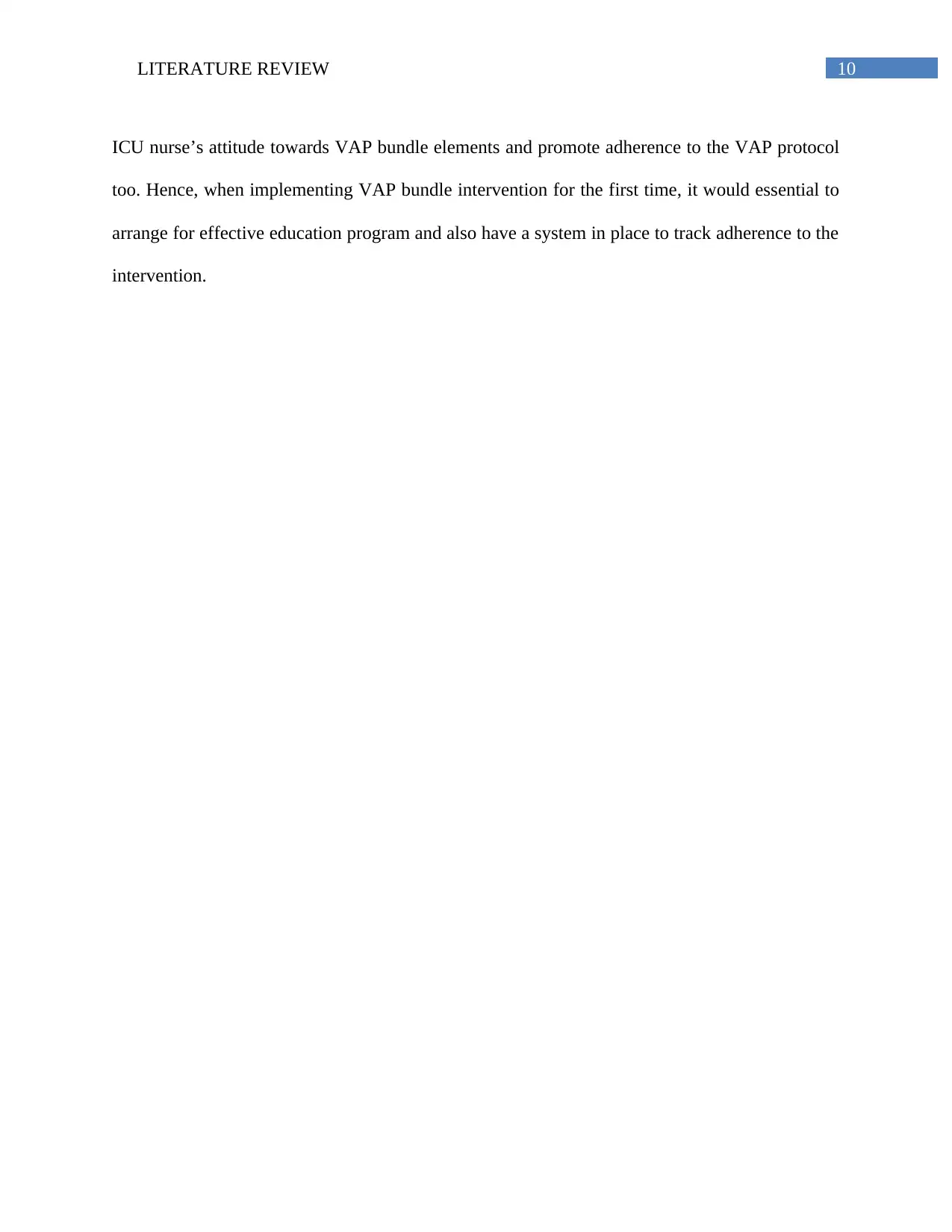
10LITERATURE REVIEW
ICU nurse’s attitude towards VAP bundle elements and promote adherence to the VAP protocol
too. Hence, when implementing VAP bundle intervention for the first time, it would essential to
arrange for effective education program and also have a system in place to track adherence to the
intervention.
ICU nurse’s attitude towards VAP bundle elements and promote adherence to the VAP protocol
too. Hence, when implementing VAP bundle intervention for the first time, it would essential to
arrange for effective education program and also have a system in place to track adherence to the
intervention.
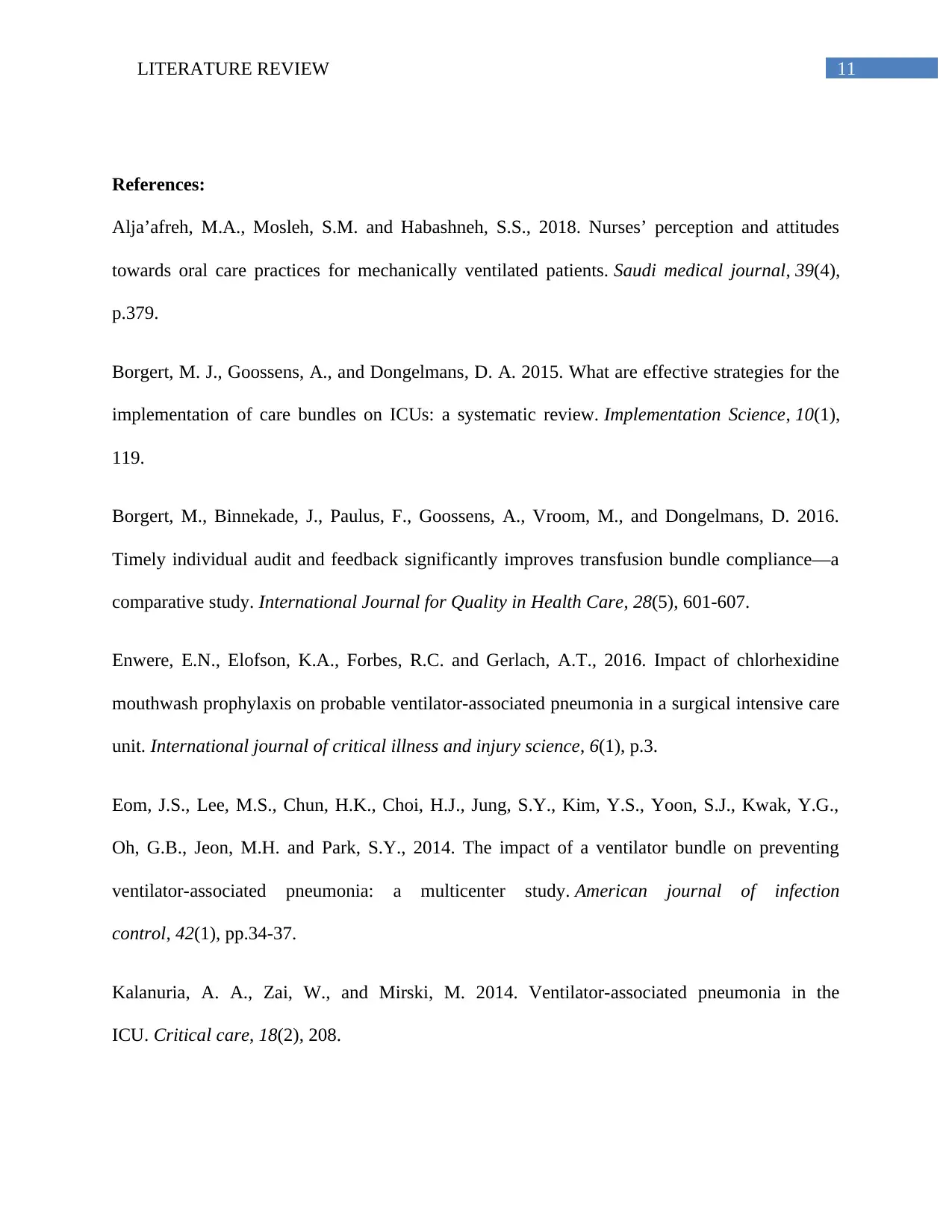
11LITERATURE REVIEW
References:
Alja’afreh, M.A., Mosleh, S.M. and Habashneh, S.S., 2018. Nurses’ perception and attitudes
towards oral care practices for mechanically ventilated patients. Saudi medical journal, 39(4),
p.379.
Borgert, M. J., Goossens, A., and Dongelmans, D. A. 2015. What are effective strategies for the
implementation of care bundles on ICUs: a systematic review. Implementation Science, 10(1),
119.
Borgert, M., Binnekade, J., Paulus, F., Goossens, A., Vroom, M., and Dongelmans, D. 2016.
Timely individual audit and feedback significantly improves transfusion bundle compliance—a
comparative study. International Journal for Quality in Health Care, 28(5), 601-607.
Enwere, E.N., Elofson, K.A., Forbes, R.C. and Gerlach, A.T., 2016. Impact of chlorhexidine
mouthwash prophylaxis on probable ventilator-associated pneumonia in a surgical intensive care
unit. International journal of critical illness and injury science, 6(1), p.3.
Eom, J.S., Lee, M.S., Chun, H.K., Choi, H.J., Jung, S.Y., Kim, Y.S., Yoon, S.J., Kwak, Y.G.,
Oh, G.B., Jeon, M.H. and Park, S.Y., 2014. The impact of a ventilator bundle on preventing
ventilator-associated pneumonia: a multicenter study. American journal of infection
control, 42(1), pp.34-37.
Kalanuria, A. A., Zai, W., and Mirski, M. 2014. Ventilator-associated pneumonia in the
ICU. Critical care, 18(2), 208.
References:
Alja’afreh, M.A., Mosleh, S.M. and Habashneh, S.S., 2018. Nurses’ perception and attitudes
towards oral care practices for mechanically ventilated patients. Saudi medical journal, 39(4),
p.379.
Borgert, M. J., Goossens, A., and Dongelmans, D. A. 2015. What are effective strategies for the
implementation of care bundles on ICUs: a systematic review. Implementation Science, 10(1),
119.
Borgert, M., Binnekade, J., Paulus, F., Goossens, A., Vroom, M., and Dongelmans, D. 2016.
Timely individual audit and feedback significantly improves transfusion bundle compliance—a
comparative study. International Journal for Quality in Health Care, 28(5), 601-607.
Enwere, E.N., Elofson, K.A., Forbes, R.C. and Gerlach, A.T., 2016. Impact of chlorhexidine
mouthwash prophylaxis on probable ventilator-associated pneumonia in a surgical intensive care
unit. International journal of critical illness and injury science, 6(1), p.3.
Eom, J.S., Lee, M.S., Chun, H.K., Choi, H.J., Jung, S.Y., Kim, Y.S., Yoon, S.J., Kwak, Y.G.,
Oh, G.B., Jeon, M.H. and Park, S.Y., 2014. The impact of a ventilator bundle on preventing
ventilator-associated pneumonia: a multicenter study. American journal of infection
control, 42(1), pp.34-37.
Kalanuria, A. A., Zai, W., and Mirski, M. 2014. Ventilator-associated pneumonia in the
ICU. Critical care, 18(2), 208.
⊘ This is a preview!⊘
Do you want full access?
Subscribe today to unlock all pages.

Trusted by 1+ million students worldwide
1 out of 15
Related Documents
Your All-in-One AI-Powered Toolkit for Academic Success.
+13062052269
info@desklib.com
Available 24*7 on WhatsApp / Email
![[object Object]](/_next/static/media/star-bottom.7253800d.svg)
Unlock your academic potential
Copyright © 2020–2025 A2Z Services. All Rights Reserved. Developed and managed by ZUCOL.





